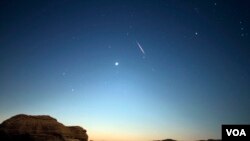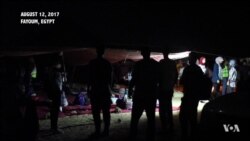The Perseid meteor shower peaks every year about this time as the Earth passes debris from the Swift-Tuttle comet, but this year the annual shower will come about a week before a total solar eclipse.
The meteor shower, which occurs each year in July or August, will see hundreds of meteors pass through the sky in an event that will be visible around the world.
Experts expect the shower to peak overnight Saturday into Sunday, though the Perseids could be a bit harder to see this year with the moon nearly full. Typical rates are about 80 meteors per hour - last year, 2016, the rate was 150-200 meteors per hour.
The shower occurs when the Earth travels through the tail of dust and ice left behind as the Swift-Tuttle comet orbits the sun. The actual meteors are usually no bigger than a grain of sand, but when they hit the Earth’s atmosphere traveling at speeds upwards of 60 kilometers per second, they burn up in a mesmerizing color show of white, orange and green hues.
The Perseids are named after the Perseus constellation, as that is where they appear to originate from in the northeastern night sky.
While the Perseids likely will draw large crowds of spectators around the world, those based in the United States will have the chance to see an even bigger astronomical event next week when the U.S. will witness the first total solar eclipse across the country in almost 100 years.
During the eclipse on August 21, the moon will pass between the Earth and the sun, completely blocking the face of the sun and darkening skies all the way from Oregon on the West Coast to South Carolina on the East Coast.
While total solar eclipses happen somewhere on Earth almost every year, they mostly occur in remote locations or over the ocean, where few if any people actually witness them. The last time a total eclipse happened over the contiguous U.S. was in 1979.








